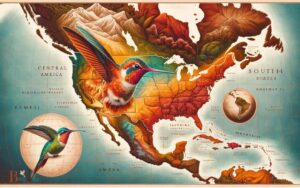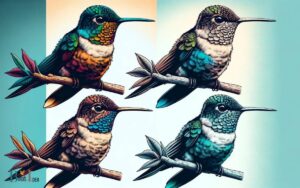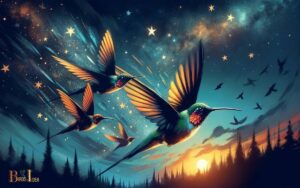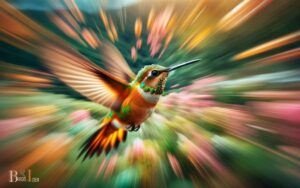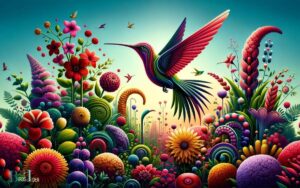What Type of Food Do Hummingbirds Eat? Nectar From Flowers!
Hummingbirds primarily consume nectar from flowers, which provides them with the necessary energy for their high metabolism. They also eat small insects and spiders for protein.
Hummingbirds have a diet that is well-adapted to their high-energy lifestyle.
The main components of a hummingbird’s diet include:
A balanced diet is essential for hummingbirds to maintain their health and their incessantly active flight muscles.
They have the highest metabolism of any bird species relative to their size, which requires them to eat half of their weight in sugar daily.
With their iridescent plumage and rapid wingbeats, hummingbirds are a dazzling sight as they flit from flower to flower, sipping nectar with their long, slender beaks.
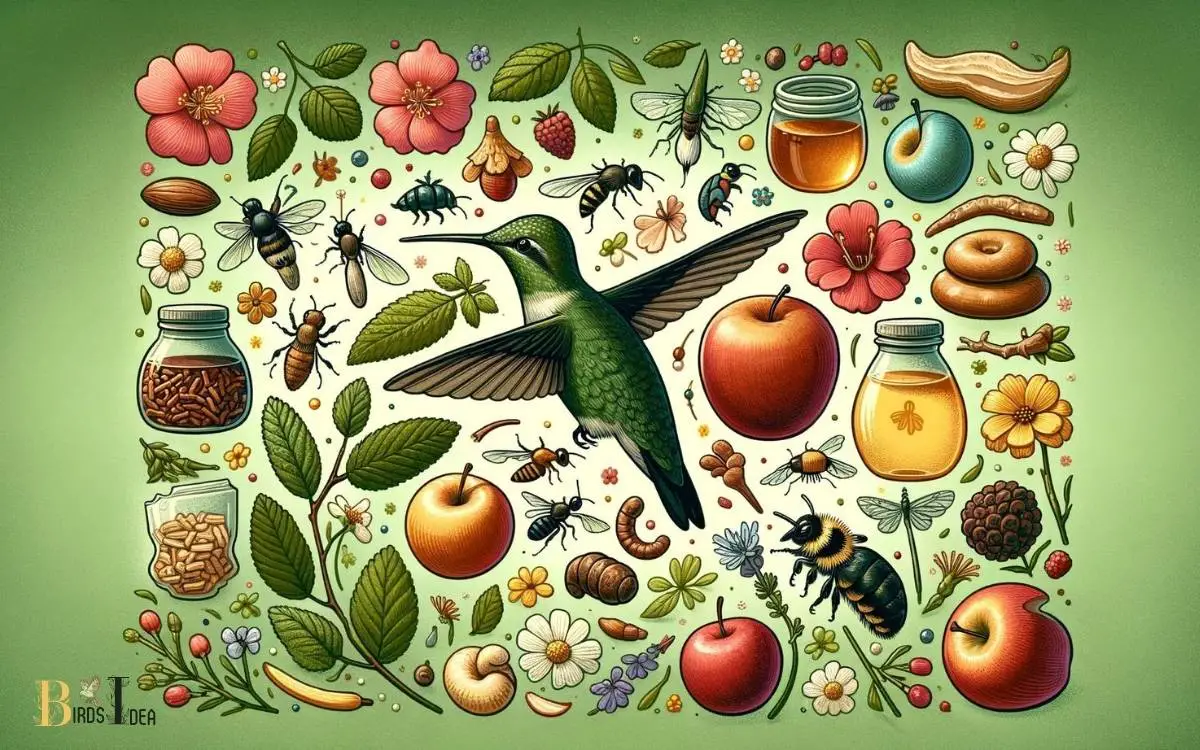
Key Takeaway
Nectar: The Main Source of Energy
Nectar, being the main source of energy for hummingbirds, provides them with the necessary fuel for their high metabolism and rapid wing beat.
Hummingbirds have an incredibly high energy requirement, with some species needing to consume up to double their body weight in nectar each day.
Nectar is a sweet liquid found in the flowers of plants and is rich in sucrose, providing a high-energy food source for these tiny birds.
Hummingbirds have developed specialized physical and metabolic adaptations to efficiently extract and process nectar, such as long, specialized beaks and tongues, as well as a unique digestive system.
The high sugar content in nectar fuels their intense activity, allowing them to sustain their hovering flight and rapid wing movement, essential for feeding and survival.
Insects: A Vital Protein Source
The hummingbird’s diet also includes insects as a vital protein source, supplementing their energy intake from nectar with essential nutrients necessary for their survival and health.
Insects provide crucial protein and fats, along with vitamins and minerals, which are lacking in nectar.
This balanced diet is especially important during the breeding season when the demand for protein increases.
Below is a table depicting some of the common insects that hummingbirds consume:
| Insect | Protein Content | Fat Content |
|---|---|---|
| Gnats | High | Low |
| Aphids | Moderate | Low |
| Mosquitoes | High | Moderate |
Hummingbirds are adept hunters, using their agility and precise beak to catch insects in flight or pluck them from leaves and branches.
This ability to supplement their diet with insects showcases their remarkable adaptation to their environment.
Spiders: Another Protein-Rich Option
Spiders are a notable element of the hummingbird’s diet, providing a rich source of protein and essential nutrients.
As natural hunters, hummingbirds are adept at catching spiders in their intricate webs or on foliage.
This protein-rich option serves as a vital component of their dietary intake, contributing to their overall health and energy levels.
Hummingbirds Eat Spiders
Hummingbirds supplement their diet with spiders, adding a protein-rich option to their usual nectar intake.
Spiders are an excellent source of protein and nutrients for hummingbirds, especially during the breeding season when they need extra energy.
The consumption of spiders also provides essential amino acids required for muscle development and tissue repair.
Here is a table illustrating the nutritional content of spiders:
| Nutrient | Amount per 100g |
|---|---|
| Protein | 48g |
| Fat | 2g |
| Fiber | 3g |
| Calcium | 50mg |
This nutrient-dense food source aids in supporting the high metabolic rate of hummingbirds, allowing them to sustain their rapid wingbeats and energetic lifestyle.
While nectar remains a primary food source, spiders play a crucial role in providing the additional nutrients necessary for their survival and reproductive success.
Protein-Rich and Nutritious
Supplementing their diet with spiders, hummingbirds incorporate a protein-rich option that serves as an essential source of nutrients, aiding in their high metabolic demands and reproductive success.
The inclusion of spiders in their diet provides several benefits:
- High Protein Content: Spiders are rich in protein, which is crucial for the growth, development, and maintenance of hummingbirds’ muscles and tissues.
- Essential Nutrients: Spiders are a source of essential nutrients such as vitamins, minerals, and amino acids, contributing to the overall health and vitality of hummingbirds.
- Reproductive Success: The protein and nutrients obtained from spiders play a vital role in supporting the reproductive success of hummingbirds, facilitating egg production and the healthy development of offspring.
This protein-rich option from spiders is a significant aspect of the hummingbirds’ diet, contributing to their overall health and wellbeing.
Natural Part of Diet
How do hummingbirds incorporate spiders into their diet as a protein-rich option to meet their high metabolic demands and support reproductive success?
Hummingbirds are known to include spiders as a natural part of their diet. Spiders are a valuable source of protein for hummingbirds, which is essential for their energy-intensive lifestyle.
These tiny arthropods provide a crucial nutrient boost, especially during the breeding season when the demand for protein is higher to support egg production and chick growth.
The consumption of spiders by hummingbirds also highlights their adaptability as nectar feeders with the ability to utilize a diverse range of food sources.
This natural inclusion of spiders in their diet showcases the remarkable ecological niche that hummingbirds occupy and their ability to exploit various food options to meet their nutritional requirements.
Types of Flowers Hummingbirds Prefer
Flowers with bright, tubular shapes and rich nectar are the types of flowers that hummingbirds prefer. These flowers are adapted to attract hummingbirds as their primary pollinators.
The following are the types of flowers that hummingbirds are attracted to:
- Red and orange flowers: These colors are highly attractive to hummingbirds and are often associated with tubular-shaped flowers, such as trumpet vine, bee balm, and penstemon.
- Long-blooming flowers: Hummingbirds are drawn to flowers that provide a consistent nectar source, such as salvia, columbine, and fuchsia.
- Native flowers: Hummingbirds have co-evolved with certain native flowers and are particularly attracted to species like cardinal flower, honeysuckle, and red buckeye.
Understanding the types of flowers that hummingbirds prefer can help gardeners and conservationists create habitats that support these remarkable birds.
Other Natural Sources of Nectar
The natural sources of nectar available to hummingbirds include tree sap, fruit juice, and the nectar of certain non-tubular flowers.
Tree sap is a valuable source of energy and minerals for hummingbirds, and they often seek it out by making small holes in tree bark.
Fruit juice, especially from overripe or damaged fruits, is also a significant natural source of nectar for hummingbirds.
Additionally, while hummingbirds are known for their preference for tubular flowers, they also obtain nectar from non-tubular flowers with shallow or flat blossoms.
These varied natural sources of nectar contribute to the hummingbird’s overall diet and provide essential nutrients for their survival and energy needs.
Common Insects in the Hummingbird Diet
Common insects play a crucial role in the diet of hummingbirds, providing essential sources of protein, fats, and nutrients.
These small creatures offer a variety of nutritional benefits for hummingbirds, including aiding in growth, providing energy for migration, and supporting overall health.
Understanding the impact of common insects on hummingbird feeding habits is essential for comprehending their dietary needs and ecological role.
Essential Insect Sources
Hummingbirds rely on a variety of essential insect sources as a primary component of their diet.
These insects provide crucial nutrients and proteins that are necessary for the hummingbird’s survival and energy needs.
The most common insects in the hummingbird diet include:
- Gnats and Fruit Flies: These tiny insects are a staple in the hummingbird’s diet due to their abundance and high protein content.
- Aphids and Leafhoppers: Hummingbirds feed on these small insects found on plants, benefiting from their protein-rich bodies.
- Beetles and Moths: Larger insects such as beetles and moths are also consumed by hummingbirds, providing a substantial amount of energy due to their size and nutrient content.
Understanding the importance of these essential insect sources is crucial for creating suitable habitats and food sources for hummingbirds.
Nutritional Benefits for Hummingbirds
Insects such as gnats, fruit flies, aphids, leafhoppers, beetles, and moths provide essential nutrients and proteins in the diet of hummingbirds, supporting their survival and energy requirements.
These insects are rich in amino acids, vitamins, and minerals, which are crucial for the hummingbird’s metabolic functions and overall health.
For instance, fruit flies are a good source of calcium and vitamin D, essential for bone strength and egg production in female hummingbirds.
Additionally, aphids and leafhoppers offer an abundance of carbohydrates, providing quick bursts of energy for the hummingbirds’ high metabolic rates.
Beetles and moths, on the other hand, are rich in fats, aiding in the hummingbirds’ energy reserves, critical for their long migratory journeys.
The diverse nutritional benefits derived from these common insects highlight their significance in the hummingbird’s diet and ultimately contribute to their survival and well-being.
Impact on Feeding Habits
The nutritional benefits provided by the variety of insects in their diet significantly influence the feeding habits of hummingbirds.
This impact is evident in the following ways:
- Protein Source: Insects such as gnats, fruit flies, and small beetles are rich in protein, which is essential for the growth, development, and maintenance of hummingbirds’ muscles and tissues.
- Energy-rich Diet: Hummingbirds feed on spiders, ants, and aphids, which provide them with a high-energy diet due to the presence of fats and sugars. This energy is crucial for supporting their rapid metabolism and high activity levels.
- Nutrient Diversity: Consuming a variety of insects ensures that hummingbirds receive a diverse range of essential nutrients, including vitamins, minerals, and amino acids, contributing to their overall health and well-being.
This diverse insect diet plays a vital role in shaping the feeding behavior and nutritional requirements of hummingbirds.
Spider Varieties Consumed by Hummingbirds
Among the various food sources available to hummingbirds, spider varieties constitute a significant part of their diet.
Hummingbirds are known to consume a range of spider species, including orb-weavers, crab spiders, and daddy longlegs.
These arachnids provide essential nutrients for hummingbirds, such as protein and other vital nutrients, contributing to their overall health and energy requirements.
The consumption of spiders also plays a crucial role in the hummingbird’s ability to meet its metabolic needs, especially during the breeding season when high-energy demands are placed on the birds.
Additionally, the consumption of spiders by hummingbirds showcases their diverse foraging behavior and adaptive feeding strategies, enabling them to thrive in various ecosystems.
Understanding the significance of spider consumption in the diet of hummingbirds provides valuable insights into their ecological role and dietary requirements.
Additional Dietary Considerations
How do hummingbirds supplement their diet beyond consuming insects and spiders? Hummingbirds have evolved to obtain essential nutrients from a variety of sources to ensure their survival and health.
In addition to insects and spiders, they also incorporate the following into their diet:
- Nectar: Hummingbirds are known for their unique ability to feed on nectar from flowers, which provides them with a source of energy-rich sugars.
- Pollen: While primarily feeding on nectar, hummingbirds also inadvertently consume small amounts of pollen, which can contribute to their protein intake and provide essential amino acids.
- Sap: Some hummingbird species have been observed consuming sap from trees, which can serve as an additional source of energy and nutrients, particularly during periods of nectar scarcity.
These additional dietary considerations play a crucial role in meeting the diverse nutritional needs of hummingbirds.
Conclusion
The diet of hummingbirds primarily consists of nectar from flowers, which provides them with the main source of energy. They also consume various insects and spiders to obtain vital protein.
The types of flowers and insects preferred by hummingbirds vary, but they play a crucial role in their diet.
Overall, hummingbirds have a diverse and specialized diet that is essential for their survival and remarkable ability to hover and dart around with great agility.

